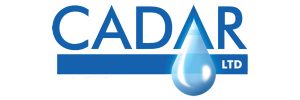Horsley WTW (2017)
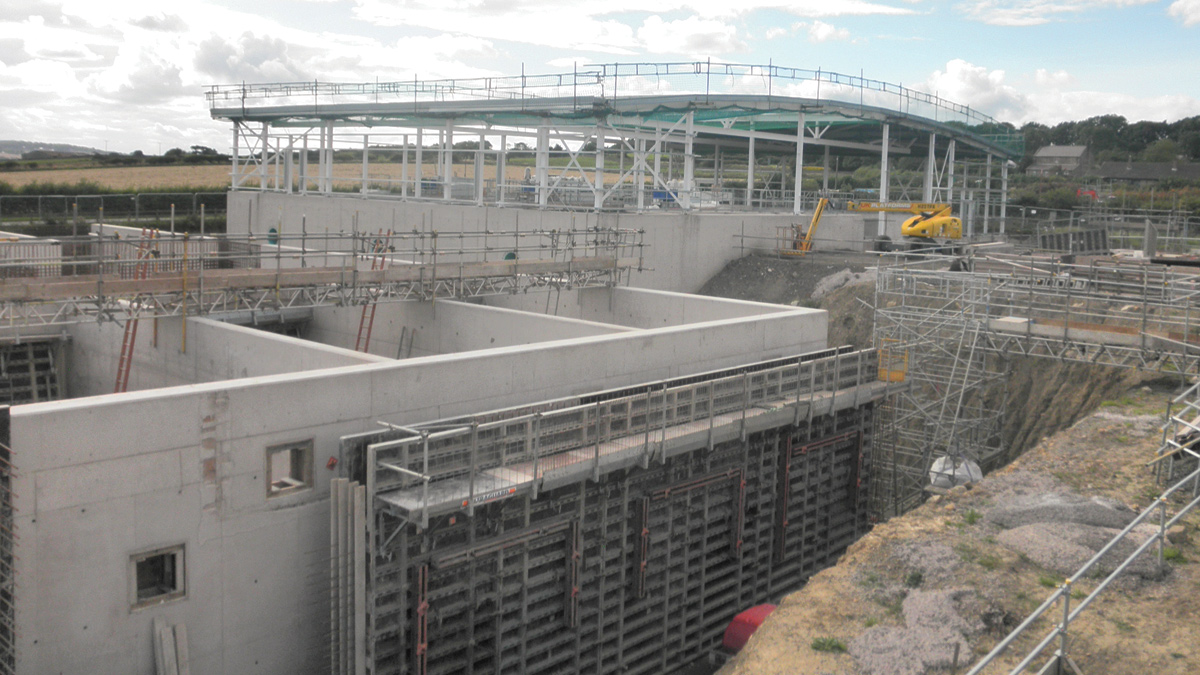
Rapid gravity filters and clarifiers - Courtesy of Doosan Enpure Ltd
Northumbrian Water’s Horsley WTW serves around 800,000 people in the Newcastle and Tyneside area. The original works was constructed in 1977 and last extended in 2003. It draws its supply from the nearby River Tyne at Ovingham and the Whittle Dene complex of reservoirs fed from Kielder Water. The existing works has a capacity of 120Ml/d, which is provided in two treatment streams, one dating from the original 1977 project, and the second from extensions carried out in 2003. Challenges to overcome included varying demand flows and low water temperatures during the winter months.
Reasons for the scheme
The purpose of the scheme is to increase the capacity of the works to 150Ml/d, to improve its ability to handle low water temperatures and to provide the facility to rapidly increase, and decrease, throughput to meet varying network demand. The scheme will also provide general improvements and upgrades to most elements of the works, including replacement of the main treated water pumping station which delivers water into the distribution network.
The design of the plant will eliminate components which could provide a single point of failure, and which could be detrimental to the ability of the works to process and supply water.
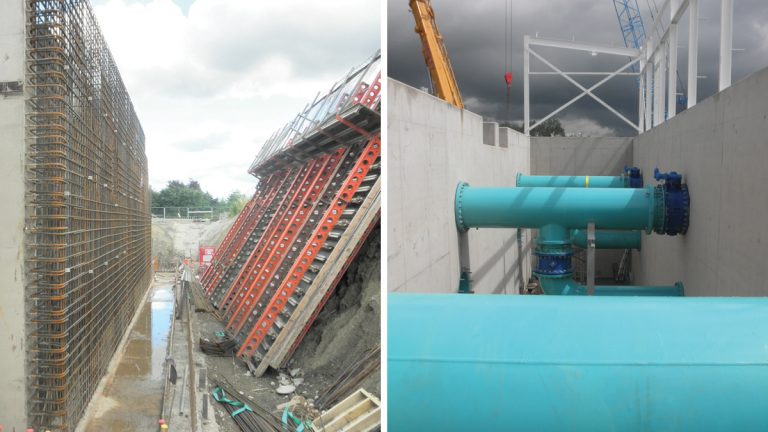
(left) Rapid gravity filter outer wall construction and (right) Clarifiers’ outlet and run to waste pipework – Courtesy of Doosan Enpure Ltd
Undertakings
The total value of the scheme is £46m and forms part of Northumbrian Water’s AMP6 programme of work. The contractor for the project is a joint venture between Interserve and Doosan Enpure Limited, working in a collaborative environment with Northumbrian Water, commercial consultants Turner & Townsend and technical consultants MWH Global (now Stantec UK).
The design and planning of the project recognises the need to maintain the existing treatment works in operation and supplying water to the distribution network. The construction and commissioning work will not restrict the existing throughput of the plant, with any necessary outages being carefully planned and restricted to a period of no greater than 24 hours to avoid any detriment to Northumbrian Water’s ability to supply their customers.
Supply chain – key participants
- Contractor: Interserve Doosan Enpure JV
- Technical Consultants: MWH Global (now Stantec)
- Commercial Consultants: Turner & Townsend
- Mechanical installation: Franklyn Yates Limited
- Motor control centres: TES Group Ltd
- Lime & PAC storage and make up plant: Spirotech Ltd
- Chemical storage and dosing plant: Gee & Company
- Filter media provision and installation: Western Carbons Ltd
- Centrifuge and sludge cake handling: Euroby Ltd
- Rapid gravity filter floors and nozzles: Cadar Ltd
- Dewatering feed progressive cavity pumps (Horsley): SEEPEX UK Ltd
- Backwash Pumps: SPP Pumps Ltd
- Static Mixers: NOV Process & Flow Technologies
- Sulphuric acid dosing plant modifications: Aquazone Ltd
- Submersible pumps: Grundfos Ltd
- Computational fluid dynamic modelling: The Fluid Group Ltd
- Pumping station physical modelling: Hydrotec Consultants Ltd
Treatment process and construction phasing
The scheme will initially provide a third clarification and filtration stream to operate alongside the two existing streams. The new stream will consist of a new clarification process and an additional bank of rapid gravity filters, with filtered water then mixing with filtered water from the existing treatment streams before undergoing disinfection by chlorination and retention in the existing combined contact tank and treated water service reservoir. The new treated water pumping station will draw from this reservoir and deliver water to an off-site network service reservoir at Birney Hill. The existing arrangements which provide feeds to Horsley village itself and the low-level supply network in the Tyne valley will be retained.
The new treatment stream will first be commissioned and tested, including the demonstration of the performance of the new plant under cold water temperatures. The newer of the two existing streams, constructed in 2003, will then be removed from service and the existing rapid gravity filters refurbished whilst operating the treatment works on the new stream and older of the two existing streams. The existing lamella clarification process on the newer of the two existing streams will be converted for dirty washwater handling.
The existing filters will then be recommissioned and tested before the older of the two existing treatment streams is decommissioned and demolished on completion of the project.
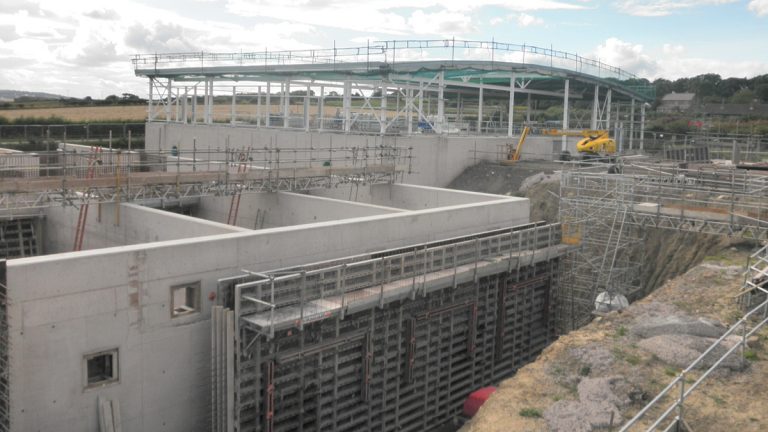
Rapid gravity filters and clarifiers – Courtesy of Doosan Enpure Ltd
New clarification and filtration process
The new clarification process stream will consist of a sand ballasted lamella clarification process, which has been previously subjected to pilot trials on the site and proven at low water temperatures. It has also been demonstrated to have rapid turn up, and turn down, capabilities, meeting a key objective of the scheme. The plant will consist of three identical streams with a total throughput of 165Ml/d, each stream consisting of flocculation stages and a lamella clarification stage with integral sludge removal.
The flocculation stage of the process will be enhanced by the addition of polyelectrolyte and poly aluminium chloride, with the addition of microsand for agglomeration into the sludge flocs to assist in the effectiveness of the removal of the solids in the lamella stage. The plant also incorporates a system where the sludge flocs removed after settlement below the lamellas are separated as far as possible from the ballast sand particles, allowing sand to be recycled to the process and minimising consumption of fresh sand.
Adjustment of the pH of the water prior to clarification will be undertaken by either the addition of lime, or sulphuric acid, depending on the requirements of the water being treated, which varies with source and through seasonal variation. Powdered activated carbon will also be dosed prior to the clarification stage for removal of organic materials.
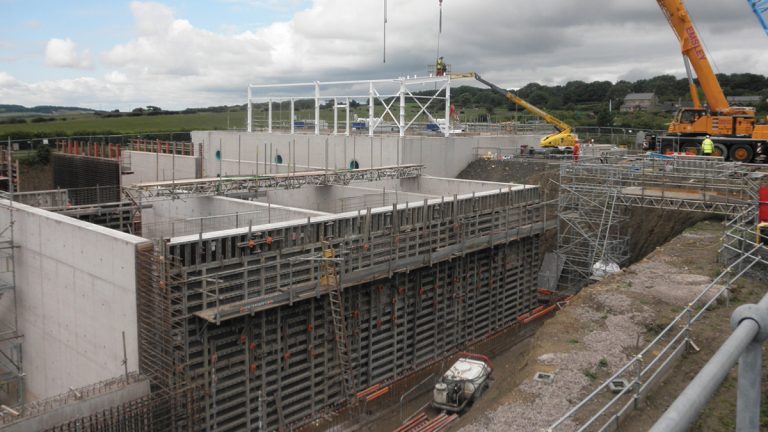
Rapid gravity filters outer wall construction – Courtesy of Doosan Enpure Ltd
6 (No.) new rapid gravity filters will be provided, each with a bed area of 72m2 and media depth of 1.2m. The filters will be of a conventional down flow design, with a nozzle plate plenum floor, incorporating sand, anthracite and manganese dioxide sand for manganese removal. Chlorine is dosed prior to filtration to enhance oxidation of manganese and removal in the filter media. New clean and dirty backwash facilities will be provided which will integrate with the operation of the existing facilities associated with the newer of the two process streams on completion.
The refurbishment of the existing filters on the newer of the existing steams will incorporate the same media specification as the new filters. The pipework will also be modified to incorporate a rinse to waste facility to discharge water on return to service after backwashing, and incorporation of outlet flow measurement and control to allow the filters to operate at constant level in the same way as the operation of the new filters.
The filtered water from the new filters will blend with that from the refurbished filters and pass to the existing pesticide removal granular activated carbon adsorption plant, with the existing option to bypass the existing plant being retained for those seasons of the year when pesticide levels are low.
- The existing orthophosphoric acid and hexafluorosilicic acid dosing points, will be retained but fully integrated into the operation of the new plant.
- The existing gaseous chlorination system will be retained, supplemented by a new sodium hypochlorite dosing facility, and will dose into the filtered water prior to entering the existing treated water service reservoir.
- The existing pH correction point will be moved from its current pre-disinfection location, to a location post disinfection to maximise the benefits to disinfection of the lower pH conditions prior to the point of disinfection.
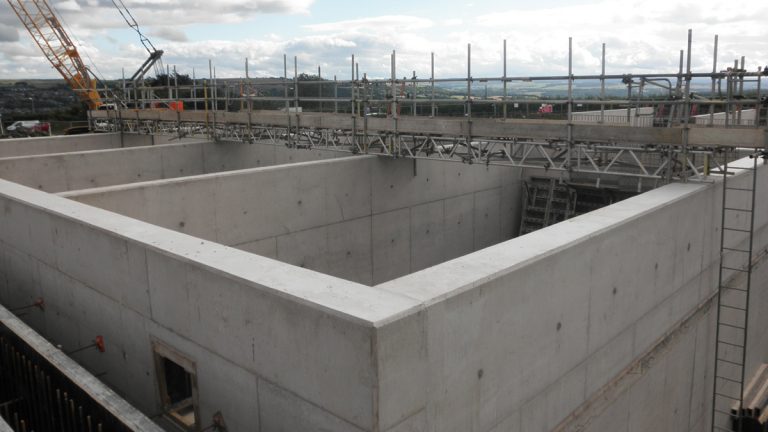
Rapid gravity filters under construction – Courtesy of Doosan Enpure Ltd
Chemical storage and dosing plant
The scheme includes for the provision of new, and improvement of existing, chemical handling facilities on the treatment works. New lime, powdered activated carbon, polyelectrolyte, sodium hydroxide, poly aluminium chloride, microsand and sodium hypochlorite storage and dosing facilities will be provided, to current specifications and standards.
Much of this plant will be housed in a dedicated chemical building constructed adjacent to the clarifier building, but use will also be made of existing redundant rooms within buildings on the site. Improvements will also be made to the existing sulphuric acid and existing gaseous chlorine dosing plant to meet the new duty of the treatment process.
Existing plant improvements
The scheme also includes extensions and improvements to other parts of the existing treatment works to allow it to handle the increased capacity and amended operation of the new process stream. A new surge vessel, housed in a new building, will be provided at the Ovingham intake, to replace the existing buried vessel and allow for maintenance and inspection to be more easily carried out.
The existing treated water pumping station, which utilises pumps operating at 3.3kV, and presents a number of difficulties for access and maintenance will be replaced with a new pumping station, utilising pumps operating at 415V housed within a new structure designed to current standards of satisfactory access and maintenance.
The dirty washwater handling plant will be improved by the conversion of an existing lamella clarifier to allow the increased dirty washwater volumes produced by the new sand ballasted lamella clarifier to be handled.
The improvements will allow the maximum recycle of settled washwater back to the inlet, as allowed by current recognised design standards, to be achieved, reducing wastewater volumes discharged from the site and limiting to those allowed by the current discharge consent.
The sludge plant will also be improved to address both capacity and reliability difficulties experienced by the existing plant. The main area of improvement will be the addition of a centrifuge, and associated cake handling conveyor, to operate in parallel with the existing sludge plate press to ensure that all sludges produced on the site can be converted to cake and minimise disposal costs.
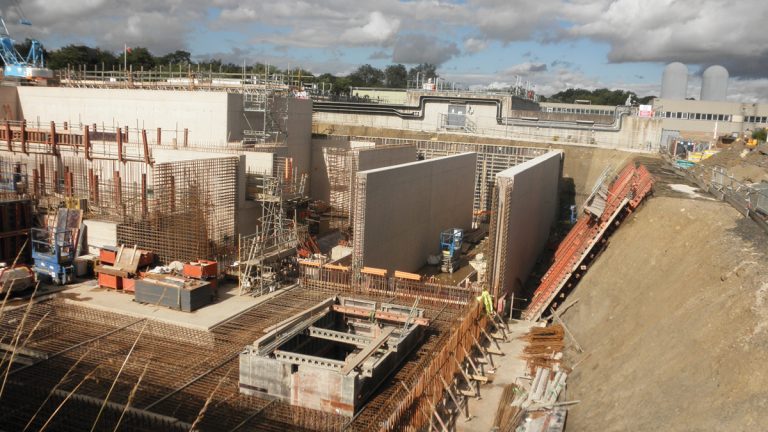
Clean washwater tank base construction – Courtesy of Doosan Enpure Ltd
Electrical works
The site-wide electrical distribution network will be modified and upgraded to accommodate the new process plant being provided under the scheme. The electrical work will include the replacement of transformers and HV switchgear and extension of the HV network. New LV motor control centres will be provided for new plant and existing motor control centres which have been deemed to have reached the end of their operational life will be replaced. Consideration will be given in the design to the need to support essential items of the plant in the event of failure of both of the dual power supplies to the site and inclusion of standby generators will be made to ensure that continued treatment of water and delivery to distribution is achievable in this event.
The existing site wide control and SCADA network will be extended to integrate new plant and modified to remove redundant plant. The work to undertake this will be carried out in a controlled and phased manner as the commissioning passes through the various stages, ensuring that processing and supply of water is maintained at all times.
Local stakeholders
The extensions to the treatment works have been subject to a number of planning conditions, which have been gradually discharged with Northumberland County Council, including some which have constrained the design, including building appearance, noise limits and site lighting.
The scheme also has a high profile in the village of Horsley and the immediate locality and the project team has undertaken a number of consultation and customer liaison events to ensure that local stakeholders are kept informed of the planned works, which has allowed good relations with the local community to be maintained.
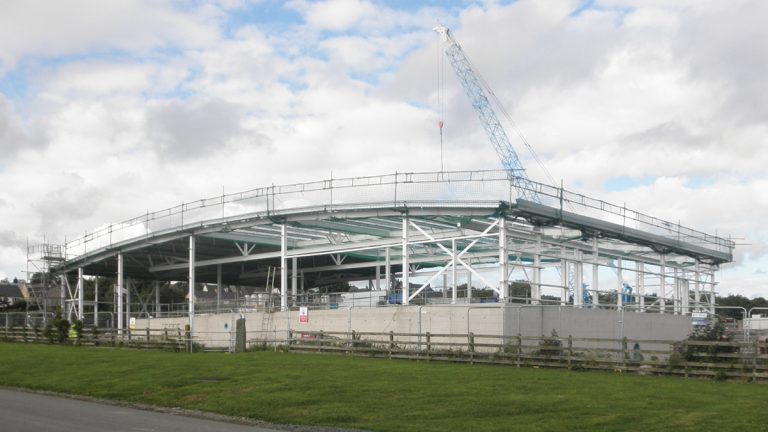
Clarifier building under construction – Courtesy of Doosan Enpure Ltd
Progress and completion
At the time of writing (early April 2017) the civil works for the new clarification process and rapid gravity filters are progressing towards completion of the water retaining structures, which will allow the main mechanical installation in the area to commence in mid-May 2017.
The main mechanical plant will be installed first, followed by the erection of buildings over the structures. Interconnecting pipework, electrical plant and interconnecting cabling will then follow.
The commencement of commissioning of the new process stream is scheduled for January 2018, with completion, including testing, by late May 2018. The refurbishment and recommissioning of the existing plant will be completed by the end of September 2018. Final tests before completion on the whole of the plant will be carried out for a further two months after this date, before the old clarifiers and rapid gravity filters are demolished. The final completion date is currently scheduled for late March 2019.






